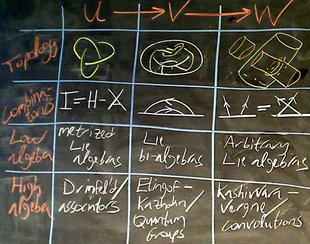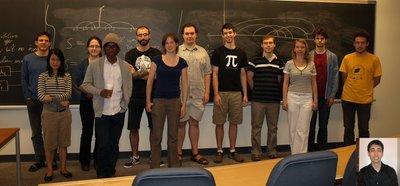|
|
| Line 4: |
Line 4: |
|
'''Solve the following problems''' and submit them in class by October 29, 2009: |
|
'''Solve the following problems''' and submit them in class by October 29, 2009: |
|
|
|
|
|
|
'''Problem 1.''' Let <math>{\mathfrak g}_1</math> and <math>{\mathfrak g}_2</math> be finite dimensional metrized Lie algebras, let <math>{\mathfrak g}_1\oplus{\mathfrak g}_2</math> denote their direct sum with the obvious "orthogonal" bracket and metric, and let <math>m</math> be the canonical isomorphism <math>m:{\mathcal U}({\mathfrak g}_1)\otimes{\mathcal U}({\mathfrak g}_2)\to{\mathcal U}({\mathfrak g}_1\oplus{\mathfrak g}_2)</math>. Prove that |
| ⚫ |
|
|
|
|
{{Equation*|<math>{\mathcal T}_{{\mathfrak g}_1\oplus{\mathfrak g}_2} = m\circ({\mathcal T}_{{\mathfrak g}_1}\otimes{\mathcal T}_{{\mathfrak g}_2})\circ\Box</math>,}} |
|
|
where <math>\Box:{\mathcal A}(\uparrow)\to{\mathcal A}(\uparrow)\otimes{\mathcal A}(\uparrow)</math> is the co-product and <math>{\mathcal T}_{{\mathfrak g}}</math> denotes the <math>{\mathcal U}({\mathfrak g})</math>-valued "tensor map" on <math>{\mathcal A}</math>. Can you relate this with the first problem of [[AKT-09/HW1|HW1]]? |
|
|
|
|
⚫ |
|
|
# Find a concise algorithm to compute the weight system <math>W_{so}</math> associated with the Lie algebra <math>so(N)</math> in its defining representation. |
|
# Find a concise algorithm to compute the weight system <math>W_{so}</math> associated with the Lie algebra <math>so(N)</math> in its defining representation. |
|
# Verify that your algorithm indeed satisfies the <math>4T</math> relation. |
|
# Verify that your algorithm indeed satisfies the <math>4T</math> relation. |
|
|
|
|
|
'''Problem 2.''' The ''Kauffman polynomial'' <math>F(K)(a,z)</math> (see {{ref|Kauffman}}) of a knot or link <math>K</math> is <math>a^{-w(K)}L(K)</math> where <math>w(L)</math> is the writhe of <math>K</math> and where <math>L(K)</math> is the regular isotopy invariant defined by the skein relations |
|
'''Problem 3.''' The ''Kauffman polynomial'' <math>F(K)(a,z)</math> (see {{ref|Kauffman}}) of a knot or link <math>K</math> is <math>a^{-w(K)}L(K)</math> where <math>w(L)</math> is the writhe of <math>K</math> and where <math>L(K)</math> is the regular isotopy invariant defined by the skein relations |
|
|
|
|
|
{{Equation*|<math>L(s_\pm)=a^{\pm 1}L(s))</math>}} |
|
{{Equation*|<math>L(s_\pm)=a^{\pm 1}L(s))</math>}} |
| Line 17: |
Line 21: |
|
|
|
|
|
and by the initial condition <math>L(\bigcirc)=1</math>. State and prove the relationship between <math>F</math> and <math>W_{so}</math>. |
|
and by the initial condition <math>L(\bigcirc)=1</math>. State and prove the relationship between <math>F</math> and <math>W_{so}</math>. |
|
|
|
|
'''Problem 3.''' |
|
|
|
|
|
|
'''Mandatory but unenforced.''' Find yourself in the class photo and identify yourself as explained in the [[AKT-09/Class Photo|photo page]]. |
|
'''Mandatory but unenforced.''' Find yourself in the class photo and identify yourself as explained in the [[AKT-09/Class Photo|photo page]]. |
Revision as of 13:14, 19 October 2009
| #
|
Week of...
|
Videos, Notes, and Links
|
| 1
|
Sep 7
|
About This Class
 090910-1: 3-colourings, Reidemeister's theorem, invariance, the Kauffman bracket. 090910-1: 3-colourings, Reidemeister's theorem, invariance, the Kauffman bracket.
 090910-2: R23 invariance of the bracket, R1, the writhe, the Jones polynomial, programming the Jones polynomial. 090910-2: R23 invariance of the bracket, R1, the writhe, the Jones polynomial, programming the Jones polynomial.
Tricolourability
|
| 2
|
Sep 14
|
 090915: More on Jones, some pathologies and more on Reidemeister, our overall agenda. 090915: More on Jones, some pathologies and more on Reidemeister, our overall agenda.
 090917-1: The definition of finite type, weight systems, Jones is a finite type series. 090917-1: The definition of finite type, weight systems, Jones is a finite type series.
 090917-2: The skein relation for Jones; HOMFLY-PT and Conway; the weight system of Jones. 090917-2: The skein relation for Jones; HOMFLY-PT and Conway; the weight system of Jones.
|
| 3
|
Sep 21
|
 090922: FI, 4T, HOMFLY and FI and 4T, statement of the Fundamental Theorem, framed knots. 090922: FI, 4T, HOMFLY and FI and 4T, statement of the Fundamental Theorem, framed knots.
 090924-1: Some dimensions of 090924-1: Some dimensions of  , ,  is a commutative algebra, is a commutative algebra,  . .
Class Photo
 090924-2: 090924-2:  is a co-commutative algebra, the relation with products of invariants, is a co-commutative algebra, the relation with products of invariants,  is a bi-algebra. is a bi-algebra.
|
| 4
|
Sep 28
|
Homework Assignment 1
Homework Assignment 1 Solutions
 090929: The Milnor-Moore theorem, primitives, the map 090929: The Milnor-Moore theorem, primitives, the map  . .
 091001-1: Jacobi diagrams, AS, IHX, STU, and the equivalence of all that with 4T. 091001-1: Jacobi diagrams, AS, IHX, STU, and the equivalence of all that with 4T.
 091001-2: The very basics on Lie algebras. 091001-2: The very basics on Lie algebras.
|
| 5
|
Oct 5
|
 091006: Lie algebraic weight systems, 091006: Lie algebraic weight systems,  . .
 091008-1: More on 091008-1: More on  , Lie algebras and the four colour theorem. , Lie algebras and the four colour theorem.
 091008-2: The "abstract tenssor" approach to weight systems, 091008-2: The "abstract tenssor" approach to weight systems,  and PBW, the map and PBW, the map  . .
|
| 6
|
Oct 12
|
 091013: Algebraic properties of 091013: Algebraic properties of  vs. algebraic properties of vs. algebraic properties of  . .
Thursday's class canceled.
|
| 7
|
Oct 19
|
 091020: Universal finite type invariants, filtered and graded spaces, expansions. 091020: Universal finite type invariants, filtered and graded spaces, expansions.
Homework Assignment 2
The Stonehenge Story
 091022-1: The Stonehenge Story to IHX and STU. 091022-1: The Stonehenge Story to IHX and STU.
 091022-2: The Stonhenge Story: anomalies, framings, relation with physics. 091022-2: The Stonhenge Story: anomalies, framings, relation with physics.
|
| 8
|
Oct 26
|
 091027: Knotted trivalent graphs and their chord diagrams. 091027: Knotted trivalent graphs and their chord diagrams.
 091029-1: Zsuzsi Dancso on the Kontsevich Integral (1). 091029-1: Zsuzsi Dancso on the Kontsevich Integral (1).
 091029-2: Zsuzsi Dancso on the Kontsevich Integral (2). 091029-2: Zsuzsi Dancso on the Kontsevich Integral (2).
|
| 9
|
Nov 2
|
 091103: The details of 091103: The details of  . .
 091105-1: Three basic problems: genus, unknotting numbers, ribbon knots. 091105-1: Three basic problems: genus, unknotting numbers, ribbon knots.
 091105-2: The three basic problems and algebraic knot theory. 091105-2: The three basic problems and algebraic knot theory.
|
| 10
|
Nov 9
|
 091110: Tangles and planar algebras, shielding and the generators of KTG. 091110: Tangles and planar algebras, shielding and the generators of KTG.
Homework Assignment 3
No Thursday class.
|
| 11
|
Nov 16
|
Local Khovanov Homology
 091119-1: Local Khovanov homology, I. 091119-1: Local Khovanov homology, I.
 091119-2: Local Khovanov homology, II. 091119-2: Local Khovanov homology, II.
|
| 12
|
Nov 23
|
 091124: Emulation of one structure inside another, deriving the pentagon. 091124: Emulation of one structure inside another, deriving the pentagon.
 091126-1: Peter Lee on braided monoidal categories, I. 091126-1: Peter Lee on braided monoidal categories, I.
 091126-2: Peter Lee on braided monoidal categories, II. 091126-2: Peter Lee on braided monoidal categories, II.
|
| 13
|
Nov 30
|
 091201: The relations in KTG. 091201: The relations in KTG.
 091203-1: The Existence of the Exponential Function. 091203-1: The Existence of the Exponential Function.
 091203-2: The Final Exam, Dror's failures. 091203-2: The Final Exam, Dror's failures.
|
| F
|
Dec 7
|
The Final Exam on Thu Dec 10, 9-11, Bahen 6183.
|
| Register of Good Deeds / To Do List
|

Add your name / see who's in!
|

|
|
In Preparation
The information below is preliminary and cannot be trusted! (v)
Solve the following problems and submit them in class by October 29, 2009:
Problem 1. Let  and
and  be finite dimensional metrized Lie algebras, let
be finite dimensional metrized Lie algebras, let  denote their direct sum with the obvious "orthogonal" bracket and metric, and let
denote their direct sum with the obvious "orthogonal" bracket and metric, and let  be the canonical isomorphism
be the canonical isomorphism  . Prove that
. Prove that
 ,
,
where  is the co-product and
is the co-product and  denotes the
denotes the  -valued "tensor map" on
-valued "tensor map" on  . Can you relate this with the first problem of HW1?
. Can you relate this with the first problem of HW1?
Problem 2.
- Find a concise algorithm to compute the weight system
 associated with the Lie algebra
associated with the Lie algebra  in its defining representation.
in its defining representation.
- Verify that your algorithm indeed satisfies the
 relation.
relation.
Problem 3. The Kauffman polynomial  (see [Kauffman]) of a knot or link
(see [Kauffman]) of a knot or link  is
is  where
where  is the writhe of
is the writhe of  and where
and where  is the regular isotopy invariant defined by the skein relations
is the regular isotopy invariant defined by the skein relations

(here  is a strand and
is a strand and  is the same strand with a
is the same strand with a  kink added) and
kink added) and
Failed to parse (unknown function "\backoverslash"): {\displaystyle L(\backoverslash)+L(\slashoverback) = z\left(L(\smoothing)+L(\hsmoothing)\right)}
and by the initial condition  . State and prove the relationship between
. State and prove the relationship between  and
and  .
.
Mandatory but unenforced. Find yourself in the class photo and identify yourself as explained in the photo page.
[Kauffman] ^ L. H. Kauffman, An invariant of regular isotopy, Trans. Amer. Math. Soc. 312 (1990) 417-471.































